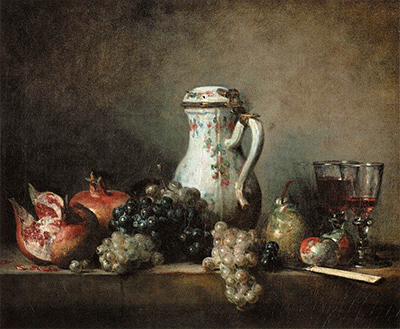Grapes and Pomegranates was one of a number of paintings exhibited by Jean-Baptiste-Simeon Chardin in 1763 that received unanimous praise. He was approaching his peak as an artist.
This still life artwork features several bunches of grapes which lie in the centre of the canvas. To our left are the pomegranates, whilst two tall glasses are placed further to the right. A large ceramic pot lies at the back, taking much of one's initial focus due to both its size and also its bright white colour. One of the bunches of grapes overhangs the table which helps to provide some vertical balance. Both the table and the wall behind a dark and without any particular details which was the normal route taken by Chardin who wanted the objects within his still life paintings to stand alone. This genre remains the area in which this artist is most famous and he achieved success through hard work combined with some well honed technical skills. Many believed he achieved these photo-realistic images with ease, but actually some indepth studies of his work have since revealed otherwise.
The light within this artwork is coming in from our left, as the artist spots each circular object on that side. His use of colour was also key to the accuracy of his paintings, where many critics would stand in amazement at paintings such as these, even if the genre was not particularly to their taste. One can argue that he achieved such perfection that he was eventually to try new challenges elsewhere in alternative genres, which he did with a series of portraits. Despite that new direction, he will always be most famous for still lifes such as this, with The Ray remaining his most loved artwork of all. He certainly tackled this style as thoroughly as anyone in art history, with all manner of different objects being rotated between each other across a number of years. He also used his own house as the base for many of these works. You will find, for example, grapes and pomegranates appearing in some of his other paintings too.
Chardin was an artist who took time to establish his career having been dragged from obscurity by a chance encounter with a fellow artist who quickly spotted his talents during a local exhibition. He rose to the ranks of the Royal Academy and then was permitted to start exhibiting at the salon. He was able, for a short time, to receive almost entirely positive feedback which was unusual for any artist of any period. Naturally, this soon changed as some of the more fickle elements of this institution started to question his versatility. Those interested in his impact as an artist should also examine some of the paintings of Fragonard, a painter who trained under his wing for a short period in order to prepare him for a later spell in the studio of colleague, Francois Boucher.




